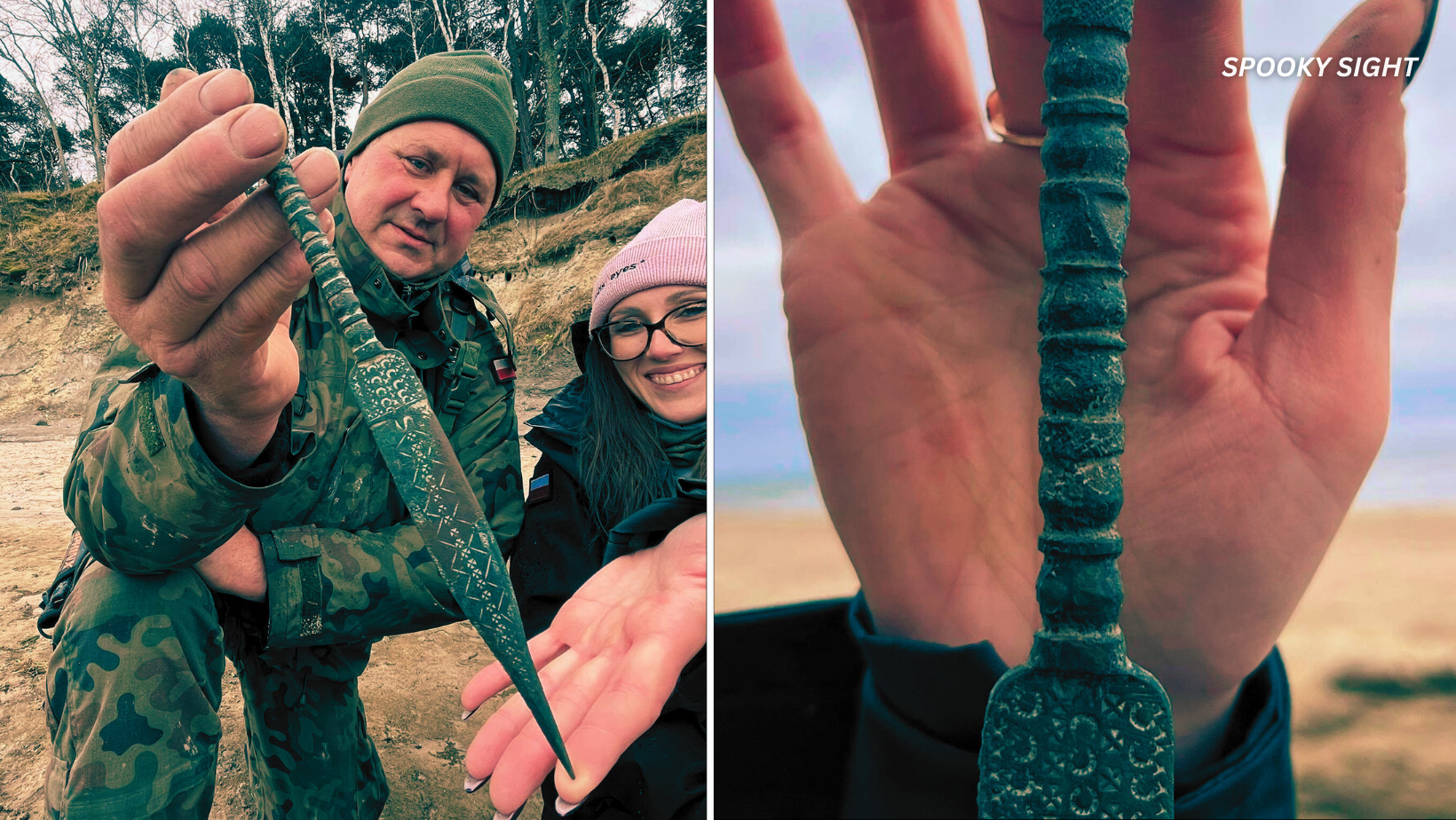In the wake of a powerful storm along the Baltic Sea, a once-in-a-lifetime discovery was made on a beach in Poland. The violent weather caused parts of a cliffside to crumble and fall to the ground below. Among the debris, two metal detectorists—Katarzyna Herdzik and Jacek Ukowski—found something extraordinary. What started as a regular day of scanning the beach quickly turned into a historical breakthrough when they unearthed a 2,800-year-old artifact: an ornately crafted dagger. The discovery was completely unexpected, as the cliffside collapse had uncovered a hidden piece of history that had been lost to time. It was not the first time that a storm had revealed something ancient, but this find stood out because of its extraordinary craftsmanship and rich historical context. The sheer size and design of the blade immediately piqued the interest of the detectorists. What had once been buried in the soil and rocks for centuries was now visible to the world, and they knew it had great significance
This unexpected event highlights the power of nature in unveiling the mysteries of the past. The cliffside, constantly eroding due to the forces of weather, had now provided a glimpse into a distant age. The relic was found intact, preserved by the environment despite its age. What started as a random search for modern-day treasures turned into a discovery that would captivate historians and archaeologists alike.
The Discovery of the Dagger
The dagger, measuring 9.5 inches in length, was unlike anything the two detectorists had ever encountered. From the moment they laid eyes on it, they realized they were holding something truly special. The ornate design, coupled with its ancient age, made it stand out among the usual finds that detectorists typically encounter. The blade was in excellent condition, with intricate markings that adorned its surface. What caught the eye of the detectorists was the presence of crescent moons and star-like symbols engraved along the blade, lending it a mysterious and almost otherworldly quality. The decoration was not simply functional; it appeared to hold deep symbolic meaning. These symbols are not typical of weapons used in combat, suggesting that the dagger might have served a different purpose altogether.
Despite the excitement of finding such an object, the detectorists knew they had to contact professionals for the next steps. They quickly alerted the Museum of the History of Kamien Land, which immediately sent experts to secure and analyze the artifact. The museum’s team quickly recognized the significance of the find and began researching its origins. The dagger’s condition and design were indicative of the Hallstatt period, which dates back to the early Iron Age. The historical context of the Hallstatt culture, known for its advanced metalworking and ritualistic practices, was an essential clue in understanding the purpose of this weapon.
In fact, the discovery wasn’t just important because of the blade itself but because of what it might represent in the broader context of the ancient world. The dagger wasn’t just a weapon; it was a tool that might have carried a deeper meaning. The fact that it was found in such an unusual location, after a natural event, makes it even more fascinating. It might have been discarded or lost long ago, only to be recovered under dramatic circumstances. The pristine condition in which it was found allowed for the possibility of uncovering a wealth of information about the period it came from.
Read more: Underwater Robot Captures A Sunken Container, Researchers Turn Pale When They Open It
Experts Weigh In on the Artifact’s Significance
When the experts from the Museum of the History of Kamien Land first examined the dagger, they were astounded by its craftsmanship and the symbols it bore. Grzegorz Kruka, the director of the museum, was particularly impressed by the quality of the design. He described the dagger as a “real work of art,” emphasizing the intricate details that set it apart from other historical finds. According to Kruka, the workmanship was of exceptional quality, and the decorations along the blade were unlike anything he had encountered in Poland before. Each element on the dagger, whether it was the crescent moon symbols or the star-like crosses, was unique and thoughtfully designed, showcasing the artistic mastery of its maker.
The intricate designs raised questions about the dagger’s possible use. While it could have been a utilitarian weapon, the decoration suggested that it may have served a more ritualistic or ceremonial function. Many scholars theorize that the symbols engraved on the blade may have been part of a solar cult, a religious practice that was prevalent in early Iron Age Europe. Solar cults often featured representations of the sun and celestial bodies, which would explain the crescent moons and star-like symbols found on the dagger. The presence of such symbols might indicate that the dagger was used in religious rituals, perhaps for offerings or ceremonies that invoked divine protection or blessings.
Intricate Designs Point to Ritualistic or Elite Use
The dagger’s elaborate decorations, including crescent moons and stars, suggest it could have been used in religious rituals or possibly belonged to a wealthy warrior. The craftsmanship and level of detail indicate that it was crafted by highly skilled metalworkers.
Read more: Secret CIA Files Say That The Ark of the Covenant Does Really Exist And They Know Its Location
Next Steps in Research: Analyzing the Dagger’s Composition
Now that the dagger has been secured, the next phase of the investigation is set to begin. Researchers are preparing to conduct a detailed analysis of the blade’s composition to learn more about its materials. The focus will be on determining the alloy’s exact makeup, including the levels of copper and tin present. This will allow scientists to gain a better understanding of the metallurgy used in its creation. Ancient metallurgical techniques are a key aspect of historical research, as they provide valuable insights into the technological advancements of the time.
One of the main questions that researchers hope to answer is whether the dagger was crafted locally or imported from another region. If it was made in Poland, it would suggest that the early Iron Age metalworkers in the area had access to advanced techniques and resources. However, if the dagger was brought in from another region, such as southern Europe, it would provide evidence of trade and cultural exchange during the period. Ancient trade routes were crucial for the spread of goods, ideas, and technology, and this dagger could help shed light on the interconnectedness of ancient European societies.
Was the Dagger Local or Imported?
Experts are also interested in determining the origins of the dagger. Was it crafted locally in Poland, or was it imported from southern Europe, possibly through trade networks of the time? This investigation could offer more insights into the cultural and trade connections of the early Iron Age.
A Valuable Find for Polish History
The dagger is expected to be put on display in a Polish museum after further analysis. This unexpected find adds a significant piece to the puzzle of ancient Polish history, offering a glimpse into the metalworking, religious practices, and social structure of the time.
A Random but Monumental Discovery
The detectorists were astounded by the discovery, which they believe was purely by chance. Ukowski described it as his most valuable find, even though it was a random event that occurred due to the storm. The artifact, however, has proven to be a remarkable contribution to Poland’s historical understanding.








